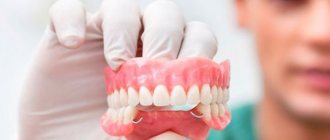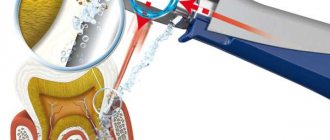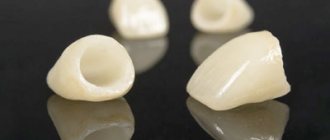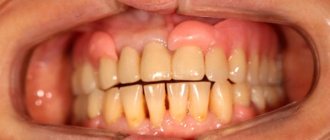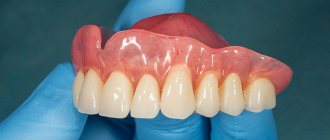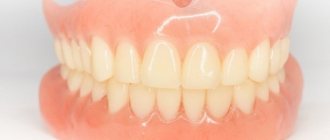April 22, 2021
Progress in all areas of medicine has not stood still for a long time, but is moving forward by leaps and bounds. Innovations have not spared dentistry, especially such a vast branch of it as orthopedics. Today, patients are offered modern types of dental prosthetics, which are much more aesthetically pleasing and comfortable than those that were available 20 years ago. And even if you have no teeth at all, but have some health problems (for example, periodontitis, diabetes, osteoporosis), then you can receive high-quality treatment and transform your smile in the shortest possible time. How? The editors of the UltraSmile.ru portal are also going to talk about this.
The latest dental prosthetics
People have been aware of the need for dental prosthetics since ancient times. The manufacture of dentures was reduced to crafts from seashells, animal bones, precious stones and even wood. But all this dental prosthetics was used only to mask the resulting defect, rather than to restore chewing function. For example, the products of ancient dental jewelers served primarily social purposes, and only then practical ones. The richest people of Ancient Rome could decorate their smiles with gold only to demonstrate their status to others.
In modern dentistry, dentures are an important part of dental treatment. The production of dentures does not stand still and constantly offers new technologies, expanding the possibilities of using various materials. It is difficult to imagine a modern person at business negotiations or at dinner with friends, giving those around him a toothless smile. Therefore, dentistry pays special attention to proper dental prosthetics, which belongs to a separate area - orthopedics. Accordingly, the doctor who performs dental prosthetics is called an orthopedist. In some clinics, dental treatment and prosthetics are performed by one doctor who specializes in orthopedics.
Temporary removable immediate prostheses “butterflies”
Not everyone knows what types of dental prostheses there are in modern dentistry. Meanwhile, such designs as immediate “butterfly” prostheses can help out in a situation where it was urgently necessary to resort to removal. They consist of a crown that imitates the lost element of the row, and wings extending from it made of acrylic or nylon. They allow you to avoid turning adjacent units of the row. Created in 1-2 hours.
The photo shows a butterfly prosthesis
They help hide the defect from others and smile without embarrassment in cases where the patient has not yet considered all types of dentures and has not made a final choice. Or when you want to save money for a comfortable, durable and expensive solution. Or, while preparations for treatment are underway, the implants take root.
Features of dental prosthetics
Each type of prosthetics has its own characteristics; let’s look briefly at each of them.
Prosthetics of anterior teeth
Requires great attention to the aesthetic side, as well as the shortest possible deadlines. This is due to the fact that few patients can afford to walk for a long time with an obvious aesthetic defect or a “hole” instead of a tooth. Also, prosthetics of the upper front teeth require the use of all-ceramic structures in order to avoid metal showing through the artificial enamel or exposing it in the gingival area.
Prosthetics of chewing teeth
Prosthetics of chewing teeth require more attention to the functional side of the issue. Here, metal-ceramics are acceptable, and in some cases even more preferable, since the strength of structures becomes more important than aesthetics. As for prosthetics on implants, it is advisable to use a two-stage technique, when the implant is first placed, and the crown is installed only after its complete osseointegration.
Prosthetics of the upper jaw teeth
If they are restored after removal, they may require a preliminary sinus lift. This is due to the close location of the maxillary sinuses (sinuses) near the roots of the upper lateral teeth. Sinus lifting is a type of bone grafting that allows you to lift the bottom of the maxillary sinus and fill the vacated space with bone tissue, which will be used to fix the titanium tooth root.
Implants with tapered abutment connection
Such structures are non-demountable. Their conical abutment ensures uniform load over the entire area of the implant, which dramatically reduces the likelihood of root loosening while chewing solid food. Such implants can be installed below the level of the cortical bone, in the area of which there is very little blood circulation.
The advantages of this technology are:
- monolithic design;
- uniform load distribution over the entire area of the implant;
- impossibility of penetration of pathogenic microorganisms to bone tissues:
- fast and very tight implantation of the implant into bone tissue;
- the technology does not interfere with normal blood circulation in the oral cavity;
- natural appearance;
- long service life.
Why is it better not to postpone prosthetics?
Where there is no tooth, the chewing load is reduced, which leads to bone atrophy - a progressive process in which the alveolar ridge, where the teeth are located, as well as the jaw as a whole, decreases. With atrophy, the lower third of the face decreases, physiological, functional and aesthetic disturbances occur. Implant prosthetics stops bone atrophy.
The load of the lost tooth falls on the rest, which leads to rapid erosion of the enamel and an increased risk of caries. Over time, you can get several severely damaged teeth in the vicinity of the defect.
If a tooth is missing, its neighbors begin to shift towards the empty space, forming bite defects that disrupt the aesthetics of a smile and interfere with chewing food well. This can lead to problems with the gastrointestinal tract.
The beauty of the smile, the elasticity of the skin and the symmetry of the face suffer, since its soft tissues rest on the teeth, and if a tooth is lost, diction may deteriorate.
Clasp dentures
The clasp itself is a thin metal arch, the basis of the prosthesis. In addition to the clasp, the design of this prosthetic system includes:
- acrylic base (imitates artificial gum);
- artificial teeth (shape, size and color are selected individually);
- fastening system (locks, clamps and crowns).
This design provides a comfortable chewing apparatus, a radiant smile, and clear speech without defects. At the same time, all taste and sensory receptors are preserved. It is also worth considering that the clasp system can be easily removed and put on; this is important when cleaning and storing dentures. New technologies for dentures have made it much easier to care for the structure; now there is no strict need to store it in water.
Types of dental prosthetics
What types of prosthetics are there and how do they differ from each other? Dentistry divides dentures into three categories: fixed, partially removable and removable prosthetics. Fixed dentures are:
Turn on adki
Essentially, these are the same fillings, but made in the laboratory using individual impressions, usually made of ceramics. They belong to non-removable dentures. They have maximum precision of fit and high aesthetics. Unlike a conventional filling, a ceramic inlay is more durable and completely invisible on the teeth.
Ceramic veneers
Fixed dentures in the form of thin ceramic plates covering the outer surface of the teeth. As a rule, this type of permanent dental prosthetics is used in the smile area to correct the shape and color of teeth.
Lumineers
Ultra-thin ceramic plates, with the help of which dental prosthetics do not require preliminary serious treatment of the teeth. Unlike veneers, lumineers can be removed, but the list of problems they can treat is very limited.
Dental crown
A cap that replaces the crown of a tooth and imitates its natural shape. The most common option for this type of denture.
Bridge prosthesis
A design of several artificial dental crowns attached to natural teeth or roots. A classic version of dental prosthetics. This category also includes an adhesive bridge, used as a temporary aesthetic structure.
Dental implant
A titanium “root” is implanted into the bone in place of a missing tooth, on which an artificial crown is installed.
All other designs are partially removable or completely removable dentures. These include:
Plate dentures
A prosthesis made of an acrylic or nylon base with artificial teeth placed on it. Can be completely removable and rest on the mucous membrane of the edentulous areas, jaws and palate. And also – partially removable with fixing elements on natural teeth. A complete removable plate denture supported by implants is the most popular and reliable type of implantation today in the absence of teeth.
Clasp dentures
Prostheses with a metal frame, which include devices that hold and unload the structure, arches and artificial teeth. The production of dentures of this type takes place in the laboratory.
Each type of prosthesis and method of dental prosthetics solves a specific functional and aesthetic problem, starting with the ugly color of teeth and ending with their complete absence.
Classic inlays instead of fillings
Today, the types of dentures offered to patients are very diverse. For example, there are those that can easily replace a conventional filling made of composite and photopolymer materials. Unlike fillings, classic inlays are created using casts of the jaws in a technical laboratory. Having undergone specialized processing, they become more durable and wear-resistant, are not subject to cracking and subsidence, and retain their tightness well. That is, the tab fits tightly to the walls of the tooth, eliminating the risk of infection and the development of caries.
The classic inlay is a modern analogue of an ordinary filling.
For comparison: a filling will last 2-3 years, and an inlay – 5-7 years. Over the entire period of operation, the tab will not lose its original characteristics and will be more convenient and beautiful.
For a modern patient, it is much preferable to choose such types of dental prosthetics as inlays made of composite, ceramic or zirconium dioxide, rather than simply putting a filling. Because after a few years the filling will have to be changed, and the hard tissues will have to be processed and ground down again, thereby reducing their thickness and shortening the life of the tooth.
Materials for dentures
Materials used in orthopedics have special requirements. They must be biologically compatible with human oral tissues and be resistant to saliva and food. Materials should not cause allergies, change taste, or have an odor. Their strength, resilience, elasticity and abrasion should be close to the tissues being replaced. In addition, an important requirement is the possible production of dentures from these construction materials, which are as close as possible in color and appearance to natural teeth and gums. Let's take a closer look at each of them.
Metal
The first metal used to make dentures was gold. Gold teeth had an absolute monopoly for 2,500 years. And even today you can still find owners of metal dentures made of gold. But today, modern dental prosthetics most often uses various metal alloys, usually as auxiliary materials. For example, when making crowns, a metal frame is first cast and then covered with a layer of ceramic. Thus, metal-ceramic dentures are created - the most popular in dentistry today.
Ceramics
The main advantage of ceramic dentures is that they are fully compatible with soft tissue, hypoallergenic and help create natural gum contours. In addition, ceramic structures can be painted in one of the shades that most accurately conveys the natural color of teeth.
Plastic
This type of material is used to create artificial teeth and bases for removable dentures. Dental laboratories use acrylic resin-based plastics to create acrylic dentures. And with the beginning of the use of non-acrylic polymers in dentistry, polyurethane and nylon dentures appeared.
Stump tabs instead of pins
What other types of prostheses are used in dentistry? The topic of dental inlays is not fully covered in the previous paragraph of the article, because in addition to classic ones, doctors today also work with stump ones. But this is a slightly different story. Classic designs are only suitable when hard tissue is destroyed by 30-50%. And if the damage is more serious, then doctors suggest restoring the shape, beauty and functionality of the tooth with stump inlays.
The photo shows the stump tabs
Previously, in such clinical situations, dentists placed a pin to strengthen the root, walls and build up the top of the tooth from composite materials, or to install a crown. Today, much more advanced dentures – inlays – are used for this purpose. What are they? Made of metal, zirconium dioxide, ceramics. Unlike pins, they do not overload the root, distribute the chewing load evenly, and eliminate the risk of fracture.
You will find the most interesting facts about this type of design in the feature article on the website.
Technology and methods of dental prosthetics
The technology of dental prosthetics does not stand still, it is constantly evolving, outdated ineffective methods are becoming a thing of the past, more and more advanced techniques and the most modern materials are appearing. Modern technologies and methods of dental prosthetics involve the widespread use of computers at all stages from diagnostics (taking 3D X-rays) to the manufacture and installation of structures. New technologies in dental prosthetics are, for example, a CAD/CAM system that allows the production of high-precision orthopedic structures using 3D computer models by sawing on a milling machine from high-strength ceramics, while just a few years ago crowns and other prosthetics were made by casting ceramics on metal frames. Thanks to the latest technologies and methods in dental prosthetics, today it is possible to make prosthetics in one visit to the doctor, when the design is made not by a technician in a laboratory, but by a special ultra-modern and high-speed machine, on which the doctor himself models the prosthesis.
Removable dentures
If the patient is not satisfied with fixed prosthetics for various reasons, the orthopedic dentist selects removable analogues to replace the lost teeth.
It can be:
- Nylon prostheses.
- Clasp dentures.
- Acrylic products.
- Zirconium “teeth”.
Each type is made using a special technology from various materials and differs in its characteristics. For example, “clasp” and artificial teeth made of zirconium dioxide are considered to be the most beautiful. They perfectly imitate natural enamel and look organic in the mouth. However, their production is a difficult task, so the cost of the finished product is quite high.
A more affordable option is acrylic products. Acrylic looks good, is not stained by food coloring, is durable and lasts for 10-15 years. Its main disadvantage is that it causes gum irritation in some patients. In this case, the orthopedic dentist suggests a hypoallergenic material – nylon. It is softer than acrylic, but wears out faster and requires more frequent replacement.
Each type of removable dentures has its own advantages and disadvantages. Therefore, in orthopedic dentistry there is a wide variety of different technologies and materials that allow us to choose the optimal solution for each client. To choose a design that is right for you, you must consult with a qualified physician. An orthopedic dentist will examine the current state of the dentofacial apparatus, soft tissues of the oral cavity and recommend an appropriate way to compensate for missing teeth.
Preparing teeth for prosthetics
Before the manufacture and installation of dentures, careful preparation for dental prosthetics must be carried out. First, any current oral problems such as tooth decay or gum disease such as periodontitis must be addressed. If some chronic diseases cannot be completely cured, it is necessary to put them into remission. Also, prosthetics may require preliminary orthodontic treatment, for example, if there is a severe malocclusion or there is not enough space to install an implant. Before aesthetic microprosthetics with veneers or lumineers, it is necessary to do whitening, and a procedure such as professional teeth cleaning will be required in any case. In addition to the above measures, an orthopedic consultation includes such preliminary steps as consulting a doctor, taking x-rays, drawing up a treatment plan and choosing the optimal type of prosthetics.
Timing of dental prosthetics
The next pressing question that worries every patient is “How long does dental prosthetics take?” There are two main calculation criteria here: whether the participation of a dental technician is required in the manufacture of dentures and whether a break is necessary between the main stages of the procedure. Almost all types of orthopedic treatment discussed in this article involve the production of dentures in a dental laboratory using individual casts of the patient. This means that installation of the prosthesis will require two visits to the dentist, with a break necessary for the construction to be made in the laboratory. However, today an increasing number of clinics are acquiring the latest models of milling machines with the ability to instantly produce orthopedic structures using 3D computer models of casts. Thus, the time required for dental prosthetics is reduced to one visit to the dentist. As for dental prosthetics on implants, here you will have to prepare for a longer treatment, since several months (from four to six) necessary for the engraftment of the titanium root may pass between the implantation of the implant and the installation of a permanent crown on it.
Veneers as an alternative to crowns
Previously, it was possible to restore dilapidated front teeth only with crowns with preliminary grinding and depulpation. Eliminate noticeable gaps between teeth using braces. In 2022, the trend is veneers, which allow you to eliminate these and other aesthetic problems of the dentition in two visits to the doctor.
A veneer is a thin ceramic overlay made individually for the patient. How the beauty of teeth returns:
- if no contraindications are found at the initial consultation, the doctor removes a thin layer of enamel from the front surface of the teeth, selects the desired shade of future veneers, makes impressions, sends them to the dental technician, and places temporary onlays;
- After 2 weeks, the doctor tries on the veneers, adjusts them to an ideal fit if necessary, and fixes them to the teeth with a special solution.
Veneers solve the problem of darkened teeth that cannot be whitened, visually correct the displacement of individual units, and mask chips, cracks, and stripes on the enamel. A Hollywood smile while maintaining the vitality of teeth is the main advantage of decorative onlays.
Stages of prosthetics
After all the preparatory procedures, the specialist proceeds directly to prosthetics, which also includes several stages.
- Preparing for installation. When prosthetics supported by implants, in some cases, preliminary bone augmentation is required. To fix a crown or dental bridge, it is necessary to depulpate, that is, remove the nerve, then fill the root and grind the surface. Before installing veneers and inlays, the doctor grinds down about 0.2 - 0.5 millimeters of dental tissue, while lumineers only need light grinding of the tooth shell.
- Making a prosthesis. Impressions of the jaw, X-rays and other necessary patient data are sent to the dental laboratory, based on which a design is created.
- Installation. The finished permanent prosthesis is adjusted to the desired size during fitting. The dentist adds highlights and shadows, adjusts the color and texture to optimally resemble the patient’s natural teeth.
Previously, depulpation was a mandatory point in the process of prosthetics, but in modern clinics doctors have different opinions about the advisability of the procedure. Removing the nerve relieves pain in the tooth area and increases its stability, but shortens the life of the tooth and accelerates tissue destruction. The specialist makes the decision on depulpation based on the diagnosis and the patient’s own feelings.
Prosthetics with telescopic crowns
Telescopic crowns are used in cases of periodontal disease, loose teeth, and when it is not possible to install implants. The design of telescopic crowns consists of 2 parts: a metal-ceramic crown and a steel cap, the walls of which are parallel. This subtype of prosthetics has a number of advantages:
- uniform distribution of chewing load between all teeth;
- it is possible to install on implants;
- the design does not affect the bite and diction;
- long service life;
- ease of operation and maintenance.
The negative aspects include the long production time and relatively high cost.
High-quality dental prosthetics
Unfortunately, the installation of dentures does not always go smoothly; sometimes incorrect dental prosthetics causes complications, and quite dangerous ones. However, it is necessary to clearly distinguish between discomfort, which invariably occurs after any serious dental intervention and is considered normal, and actual complications. If after the procedure for one, two or three days (depending on the type of prosthetics) there is slight bleeding in the area of the soft tissue incision, slight swelling or pain suppressed by painkillers, there is no need to sound the alarm, unless the pain is sharp and the bleeding not plentiful. If, within a few days after prosthetics, the tooth hurts very much, the bleeding does not stop, and the swelling does not subside, this means that the doctor made mistakes during dental prosthetics.
Materials for prosthetics.
A few years ago, orthopedic dentistry could only offer uncomfortable removable structures. Today, different methods of prosthetics are available to patients using high-quality materials. Unpractical plastic has been replaced by flexible nylon. It is much more practical and reliable than acrylic plastic. Orthopedic systems created on the basis of a nylon base have a number of advantages:
- They are durable.
- Their shade matches the color of the enamel and gums.
- Can be secured using suction cups.
- The patient gets used to flexible structures much faster.
- When used, do not injure the oral cavity.
To create permanent systems, namely crowns, modern prosthetic dentistry offers several types of materials. Most often, patients use ceramics to restore their front teeth. It perfectly imitates the appearance of incisors, but unfortunately, it is not sufficiently resistant to mechanical stress. To replace molars, stronger dentures are needed that can withstand heavy loads. In this case, crowns made of metal or composite are suitable.
- Zirconium dioxide is a durable material that is completely biocompatible with the human body and does not cause allergic reactions or inflammatory processes. A patient with such teeth has nothing to fear; they will not break or crack. To create crowns from zirconium, special equipment is required, since the material is very hard and cannot be processed by hand. Today this is the most durable and aesthetic method of prosthetics.
- Metal-ceramics is a permanent structure made of a metal base, covered with ceramics on top. This is the best option if you are looking for reliable and inexpensive crowns. They can be used to restore both chewing and front teeth. Their only drawback is that the frame is translucent, so the color of the enamel darkens over time.
Depending on the clinical case, the patient himself chooses the basis for the prostheses, based on his financial capabilities. A variety of materials allows you to install high-quality products at an affordable price.
Dental prosthetics under anesthesia
Implant-supported prosthetics involve major surgery, so the operation is always performed under anesthesia. Patients often choose the most comfortable type of pain relief - sedation or general anesthesia. Local anesthesia is also effective, but some patients find it psychologically difficult to perceive unpleasant sounds and smells during the procedure.
Correct and high-quality installation of a crown or bridge should not cause severe pain. In this case, local anesthesia is used to alleviate discomfort during depulpation, grinding of the tooth and fixation of the structure.
When performing prosthetics with inlays and veneers, an injection of local anesthesia is used, since grinding down the dental tissue causes pain.
Pain after prosthetics
Pain after dental prosthetics can mean prosthetic stomatitis, an inflammatory disease of the soft tissues at the point of contact of the crown and gums. This may occur due to the fact that the crown is put on too “tightly”, as a result of which it puts pressure on the gum, irritating it and injuring it. Pain may occur some time after the installation of a bridge, and one or both supporting teeth begin to hurt. This may mean that caries has gotten under the dentures and affected the supporting teeth. The reason for this is the loose fit of the crowns to the teeth, too large a gap between the bridge and the gum in the place where the tooth is missing, or the ingress of saliva during prosthetics.
Also, do not forget about such an insidious phenomenon as an allergy to the materials from which prostheses are made. If you suffer from at least one type of allergy, before getting prosthetics, you should check your body for compatibility with prosthetic materials.
Photos before and after prosthetics
Constructions without a palate
You don’t know everything about modern dentures if you haven’t heard anything about those that have a reduced palatal overlap or no palatal overlap at all. And such designs actually exist today and make the life of patients who have defects in the upper jaw much easier.
Devices without a palate are unique in that they have a more compact size compared to their massive and outdated counterparts made of acrylic, nylon, and silicone. As the name suggests, they do not cover the palate, which is very sensitive and where many taste buds are located. Thanks to this, patients can taste food, not experience a gag reflex, and speak normally. In general, such designs are quite comfortable, and you can read about all types of palateless dental prosthetics in more detail on our website.
This is what a sandwich prosthesis looks like
Modern removable dentures are more comfortable and aesthetically pleasing than their outdated types. However, even the highest quality of them are unable to transfer the full chewing load to the bone tissue, as a result of which it atrophies, that is, decreases in volume. As a result: the structures do not adhere tightly to the mucous membrane, begin to shift and fall out, and cause physical and psychological discomfort. And the problem has to be solved by frequent relocation of the devices at the orthopedic dentist and the use of fixing creams (Korega, Protefix).
Cost of dental prosthetics
Prices for dental prosthetics vary widely and depend on many factors. The first is, of course, the material. The more expensive it is, the higher the cost of dental prosthetics will be. The highest prices for dental prosthetics are ceramic veneers, which are classified as permanent dentures. The lowest cost is for removable dentures made of plastic, in particular acrylic. The cost of nylon dentures will be higher. The second factor is the amount of work. It is one thing if it is necessary to compensate for the loss of one tooth, and quite another if all are missing. For example, the price of clasp prosthetics in Moscow also depends on the qualifications of the orthopedist and dental technician, the use of modern technologies and equipment when creating an orthopedic design.
Removable nylon and acrylic dentures
Removable orthopedic structures have been known for a long time, but this method of replacing missing teeth is constantly being improved in order to improve functionality, strength, aesthetic properties, and reduce the duration of the adaptation period.
If earlier dentures were made of acrylic, now this fragile, hard, unhygienic and not the safest material is abandoned in favor of strong, soft, non-toxic and durable nylon, which does not emit phenol, does not accumulate bacteria and does not absorb odors due to its dense non-porous structure .
Flexible nylon
In addition to their environmental friendliness, nylon prostheses have the advantage of good compatibility with tissues, hypoallergenicity, and the virtual absence of contraindications. However, they also have disadvantages. This is possible bone atrophy and the need for periodic replacement. In addition, the price of nylon is higher than that of acrylic.
What types of dental prosthetics are best?
Every person who decides to undergo prosthetics, of course, is concerned with the pressing question: “What type of dental prosthetics is better?” Here you must first make a reservation about what kind of prosthetics we are talking about: the restoration of destroyed or damaged teeth or the replacement of a completely missing tooth (or several teeth). In the second case - when you need to restore a lost or extracted tooth - to the question “Which dental prosthetics should I choose?” There is only one answer: of course, implantation. However, here too you need to remember that there are pitfalls - for example, contraindications. As for the high price of dental implantation in Moscow, which scares off many patients and forces them to settle for less effective types of prosthetics, it is worth comparing the costs more carefully. The fact is that implants, if all installation rules are followed and with proper care, serve a person for a lifetime, and the crowns on them need to be changed no more often than once every ten, and sometimes fifteen years. As for, for example, bridges, the most popular alternative to implantation, they require replacement on average every five to seven years. In addition, the supporting teeth during bridge prosthetics tend to become loose, which also leads to their loss or destruction. In this state of affairs, the cost of implantation in the long term does not exceed the cost of bridge prosthetics.
However, in the case of prosthetics for partially, completely destroyed or lost teeth, your attending physician will tell you in detail how to choose the optimal treatment method for your specific situation. Remember that no conscientious doctor will remove a tooth and install an implant in its place if this tooth can be at least partially saved and restored using other types of prosthetics. Although an implant is the highest quality type of prosthetics, a native tooth, even if only the root remains, is still better.
Modern dental treatment - advances that have played a decisive role in the development of the industry
The most important breakthroughs in the dental field include:
- computer technologies for high-precision diagnostic procedures, therapy, prosthetics;
- digital radiology;
- laser beams to eliminate oral diseases;
- ozone for treating destroyed units and carious “holes”;
- grinding crowns with a powerful air stream;
- modern treatment of caries using safe anesthetics that completely block the occurrence of pain;
- new generation materials for prosthetics, manufacturing of inlays, fillings, implants, veneers.
Use of computer technology
It is difficult to imagine modern prosthetics without advanced computer technologies. Innovative programs make it possible to accurately model a person’s oral cavity in his absence and accurately determine the shape of the prosthesis that will suit him.
Computer technologies are used both in making a diagnosis and in selecting treatment methods. Particularly surprising are the achievements of neuromuscular dentistry aimed at studying the patient’s masticatory muscles. It is safe to say that current computer programs make it possible to create prostheses that are in no way inferior to natural analogues that were donated by nature but collapsed.
Another important innovation is intraoral video cameras. They make the work of doctors easier and allow them to examine every millimeter of the working surface. Provide maximum comfort for both the dentist and the patient.
Laser in dentistry
Laser beams can solve many dental problems:
- carry out a safe fight against caries;
- treat periodontitis and periodontitis;
- eliminate the tendency to bleeding gums;
- make cuts without using a scalpel;
- carry out complete disinfection of the oral cavity.
If you compare laser techniques with older traditional ones, the following advantages will become obvious:
- all treated surfaces will be disinfected more efficiently;
- bleeding during dental surgery is completely eliminated;
- surrounding tissues are practically not injured;
- regeneration processes after therapy proceed at an accelerated rate.
The laser method has almost no disadvantages, except for its high price.
Ozone in dentistry
Dentists use ozone most often when treating shallow carious cavities. The technique is absolutely painless. It makes it possible to abandon the use of a drill, which is scary for many.
Ozone qualitatively disinfects the surface being treated and has a positive effect on the condition of the enamel. Its use is especially relevant when it comes to the treatment of caries in children.
Air grinding of dental crowns
Grinding makes the surface of the filling and restored crown perfectly smooth without the use of a traditional drill. The air flow acts very carefully, precisely, and does not damage surrounding healthy tissue, so the procedure is as safe as possible.
Innovative anesthetics that guarantee no pain
Perhaps new drugs for pain relief are the basis for the development of the dental industry. They are important not only for doctors, but also for patients. After all, for clients of dental clinics, the question of painless treatment has always remained open. Today we can say that it has been resolved.
The latest generation anesthetics serve as an excellent replacement for novocaine and lidocaine. They are stronger, but have minimal side effects. Many of them are suitable even for expectant mothers, as they do not cause negative consequences for the health of the fetus.
In addition to painkillers, sedation (shallow sleep during a traumatic and painful procedure) deserves special attention. The patient is given inhalation, during which he falls asleep. He wakes up already when the therapy is completed. The advantage of sedation is that it is safer than general anesthesia.
Unique materials for fillings, prosthetics and implantation
When closing carious cavities, dentists use the latest composite compounds - liquid fillings and photo fillings. They quickly penetrate even the most inaccessible places, accurately follow the shape of the “hole,” harden almost instantly under the influence of ultraviolet radiation, and at the same time are very durable.
When replacing and restoring damaged units, inlays and crowns are made of zirconium oxide, a thin material that looks as beautiful as natural enamel, but is also incredibly durable.
Don't forget about lumineers - the thinnest overlays that do not require preliminary grinding of the enamel. They perfectly mask chips, unsightly fillings, and make the smile line more harmonious in one visit to the dentist.
Thanks to innovative treatment methods, even a person with severely damaged teeth can now count on getting a healthy and very beautiful smile. And this is a very important achievement of researchers, developers and dentists themselves.




